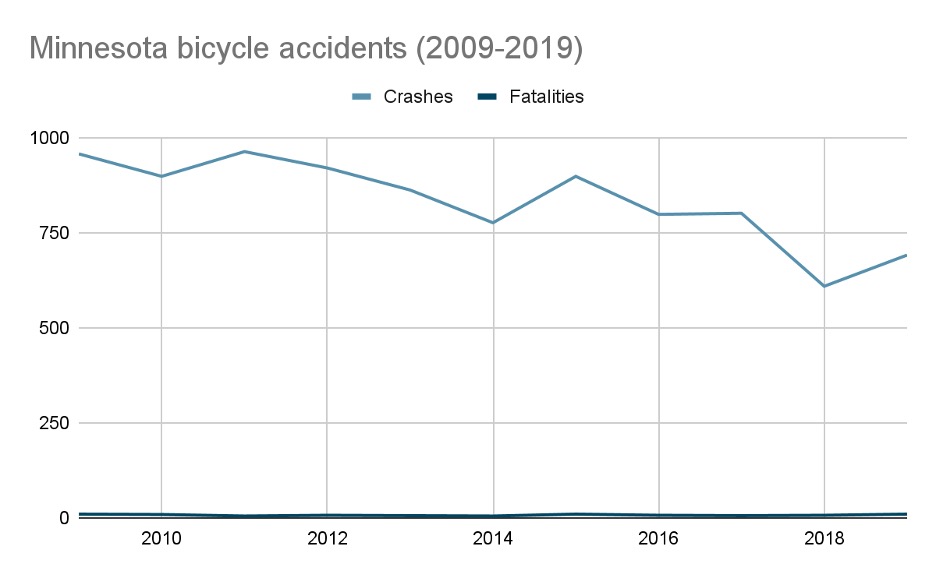
Find out how to recover damages following a bike accident, including whether your auto insurance policy covers bike accidents
You might think that you have a better chance of spotting a white peacock than you do a bicyclist in Minnesota. After all, the North Star State isn’t exactly known for its year-round warm weather.
Nevertheless, Minnesota’s bike scene is thriving.
The state is home to more than 4,000 miles of bike trails, including the Root River, Paul Bunyan, and Central Lake trails. The League of American Bicyclists ranked Minnesota the 3rd most bike-friendly state in the entire country, and Bicycling magazine named Minneapolis the country’s #1 bike city.
Unfortunately, even in a bike-friendly state like Minnesota, bicycling can be dangerous.
Let’s take a look at bike accidents in Minnesota, including the laws that cyclists should know about and how cyclists can receive compensation following a bike crash.
Is it safe to bike in Minnesota?
Bike accidents have generally trended downward in Minnesota since 2005, although the number of fatal bike accidents has remained somewhat steady from year to year.

Bicycle crashes are more common in warmer months, which is not too surprising considering there are more cyclists out when the weather is nice. However, in 2019, there were bicycle crashes during each month of the year.
There are all sorts of factors that contribute to bike accidents, but being aware of the most common actions taken by cyclists prior to a crash may help you avoid a crash:
| Prior action of bicyclists involved in crashes in Minnesota (2019) | |||
|---|---|---|---|
| Prior action | Bicyclists in fatal crashes | Bicyclists in injury crashes | Bicyclists in property damage crashes |
| Cycling across traffic | 4 | 312 | 16 |
| Cycling with traffic | 4 | 158 | 18 |
| Cycling against traffic | 0 | 26 | 6 |
| Cycling on sidewalk | 0 | 74 | 6 |
| Standing or stopped | 0 | 4 | 0 |
| Other | 2 | 55 | 12 |
| Source: MDPS | |||
Laws that bicyclists in Minnesota should know about
Most of the laws specific to bicycling can be found in Chapter 169 of the Minnesota Statutes. These laws address everything from required equipment to whether cyclists need to carry a driver’s license.
Let’s answer some of the most common questions about bicycle laws:
Do I have to wear a helmet when riding a bike?
Minnesota state law does NOT require bicyclists to wear helmets.
With that being said, bicycle helmets are strongly encouraged. Studies show that bicycle helmets are 85-88% effective in mitigating head and brain injuries.
When purchasing a helmet, be sure it’s approved by the Snell Memorial Foundation (SNELL) or American Society for Testing and Materials (ASTM), and the Consumer Product Safety Commission (CPSC).
Do I have to obey the same traffic laws as motor vehicle drivers?
Minnesota Statute 169.222 states that “every person operating a bicycle shall have all of the rights and duties applicable to the driver of any other vehicle.”
To put it another way, you need to obey the same traffic laws as motor vehicle drivers unless those traffic laws cannot reasonably be applied to bicyclists.
Can I get a DWI while riding a bike?
Riding a bike while intoxicated is a very bad idea.
According to a research study published by the International Journal of Surgery, roughly ⅓ of injured cyclists screened for alcohol are intoxicated.
With that being said, you cannot be charged with a DWI while operating a bicycle in Minnesota.
Can a motorist drive or park in a bike lane?
Minnesota Statute 169.18 states that motorists cannot drive or park in bike lanes. What’s more, no person shall stop or stand in a bike lane except to avoid conflict with other traffic or to be in compliance with the instructions of a police officer.
Is lane splitting legal?
Lane splitting (sometimes called “stripe riding”) is when a bicyclist (or motorcyclist) rides between 2 lanes of cars heading in the same direction. Most cyclists split lanes when traffic slows, but some cyclists also split lanes in order to filter to the front of traffic at a stoplight.
Regardless of the reason, lane splitting is prohibited in Minnesota.
Do I have to ride in the direction of traffic?
Minnesota Statute 169.222 states that a bicyclist on the roadway in a traffic lane must ride in the direction of traffic, as must a bicyclist on the shoulder or in a bike lane.
Is there any law against motorists opening their doors in front of bicyclists?
The term “dooring” refers to the act of opening a motor vehicle door into the path of another road user (typically a cyclist).
Minnesota Statute 169.315 strictly prohibits dooring. The law states that no person shall open any door on a motor vehicle unless and until it can be done without interfering with the movement of other traffic.
What’s more, no person shall allow any door to remain open for a period of time longer than necessary to load or unload passengers.
Is it legal to text while cycling?
Texting while operating a bicycle is an extremely dangerous and stupid thing to do. It’s not, however, strictly prohibited under Minnesota law.
How to receive compensation after a Minnesota bike accident
Minnesota is a no-fault insurance state. This means that motor vehicles drivers injured in an accident file insurance claims with their own insurance company first regardless of who’s at fault for the accident.
What does this mean for cyclists?
Even if you’re injured on your bicycle, your auto insurance—specifically, your personal injury protection (PIP) policy—will typically provide some compensation regardless of who was at fault for the accident (assuming your accident involved a motor vehicle).
If you don’t have auto insurance, you may be able to receive coverage if someone in your family has auto insurance.
If your damages exceed the limits of your PIP coverage, you’ll need to make a claim against the at-fault driver’s liability insurance or file a personal injury lawsuit against the at-fault driver.
When making a claim against the motor vehicle driver or filing a personal injury lawsuit against them, you’ll need to prove that they were responsible (i.e., at fault) for the accident.
In most cases, proving fault means proving that the driver was negligent. To do this, you’ll have to establish that:
- The driver owed you a duty. All drivers have a duty to exercise reasonable care to avoid harming others on the road, including cyclists and pedestrians.
- The driver breached their duty. To prove that a driver breached their duty, you’ll need to show that the driver failed to exercise a reasonable degree of care. For example, if the driver ran a red light or was texting while driving, this may constitute a breach of duty.
- The bicyclist was injured as a result of the driver’s breach. It’s not enough that the driver failed to exercise reasonable care, the bicyclist must prove that the failure caused their accident and resulting injuries.
Statute of limitations in Minnesota bicycle crashes
Minnesota limits the amount of time you have to file a personal injury lawsuit. This time limit is called the statute of limitations. The statute of limitations for most bike accident cases is 2 years from the date of the accident.
If you’re under the age of 18 at the time of the accident, the 2-year clock typically won’t start running until you turn 18.
Contributory negligence in a Minnesota bicycle accident
Under Minnesota’s contributory negligence law, a plaintiff’s damages are reduced by their percentage of fault. What’s more, if the plaintiff is found to be more than 50% responsible for the accident, they’re barred from recovering ANY damages.
Steps to take after a bike accident in Minnesota
Even “minor” bike accidents can be traumatic. However, you can increase your chances of recovery down the road by staying calm and completing the following steps:
- Call an ambulance. Minnesota law requires individuals involved in an accident to stay at the accident scene and render reasonable aid to anyone who’s injured. If you suffered an injury, call an ambulance or have someone call an ambulance for you.
- Call the police. Calling the police is always a good idea after a bike accident. The police can make your life easier by collecting witness statements and contact information for the parties involved. What’s more, the police can diffuse any potential road rage incidents (something all too common when bikes and motor vehicles collide).
- Gather information. Don’t simply rely on the police to gather information to help your case. Collect the contact information for any party involved in the crash as well as any witnesses who may have seen the crash.
- Contact your insurance company. Remember, Minnesota is a no-fault insurance state, so it’s imperative that you contact your own insurance company as soon as possible after the accident to see what coverage they provide.
- Avoid social media. Avoid posting about the accident on social media. More often than not, social media posts end up hurting plaintiffs who file lawsuits.
Finally, if you’ve been involved in a bike accident in Minnesota, contact an experienced bike accident attorney near you using our free online directory.
See our guide Choosing a personal injury attorney.
